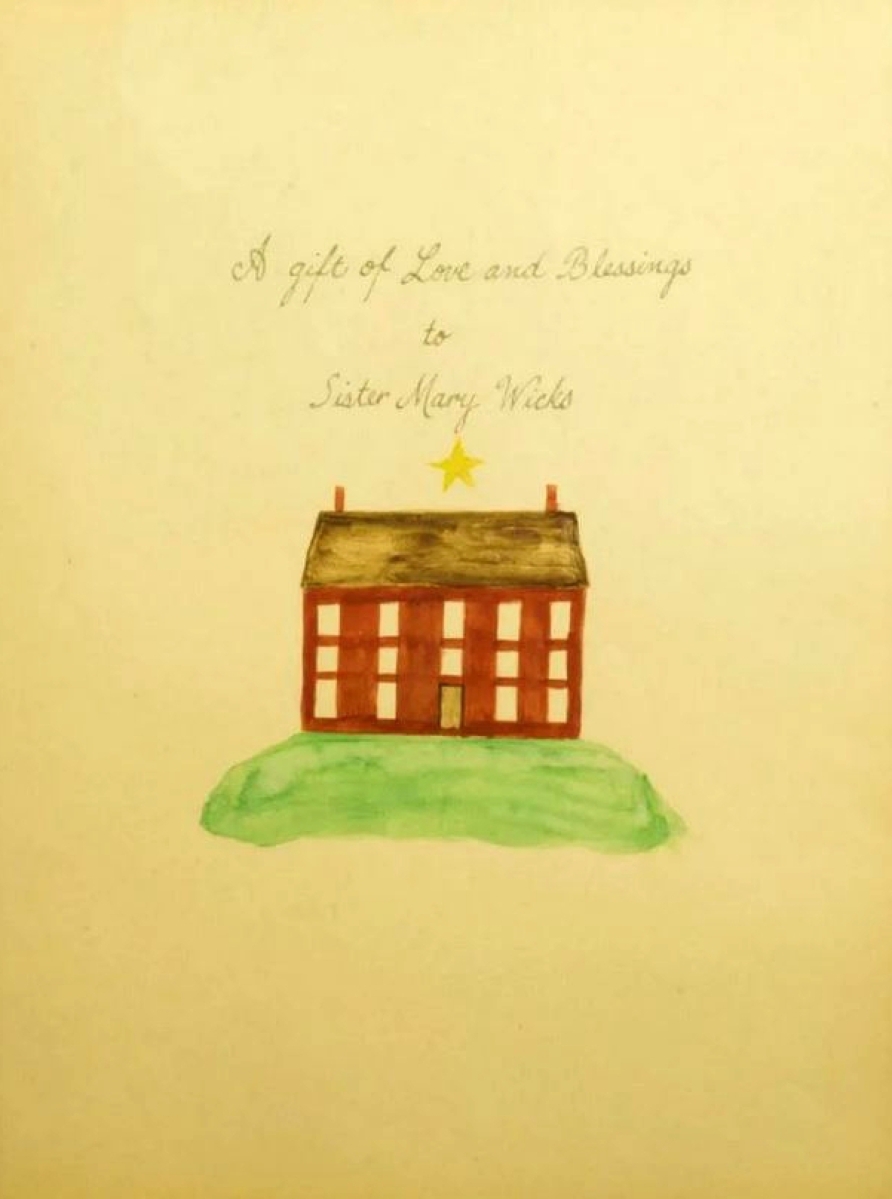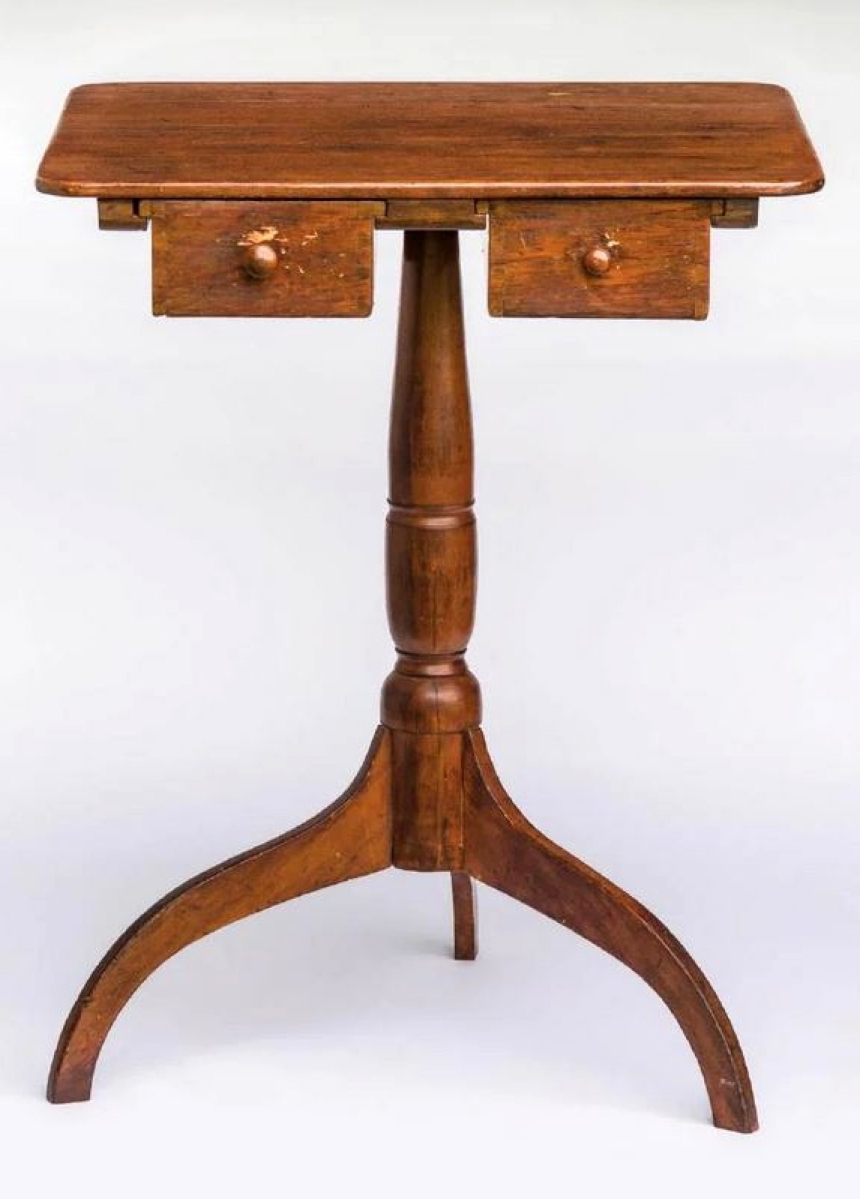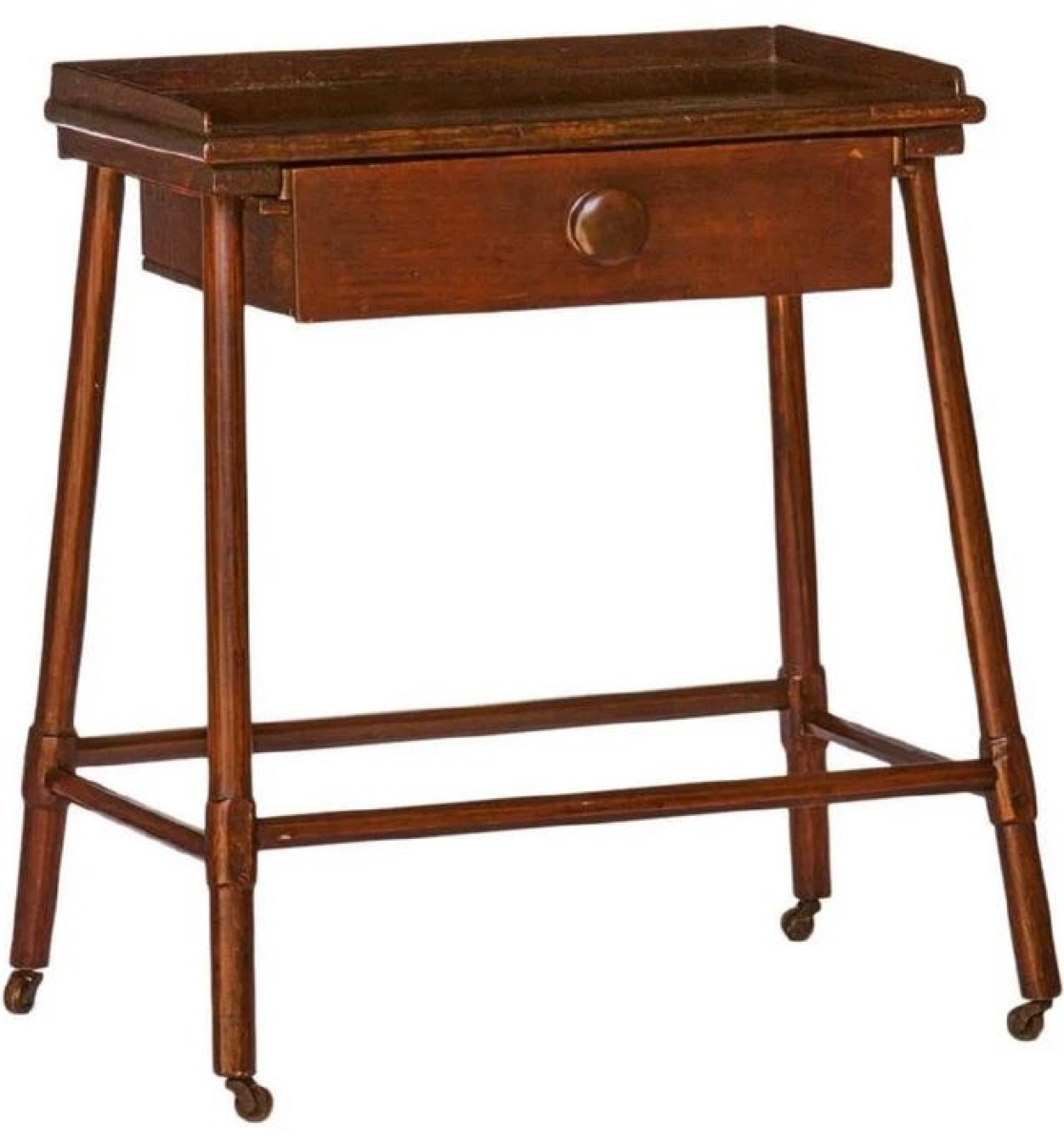
The sewing cabinet had three-over-two-over-one drawers and a pull at the top center that the catalog described as “possibly used to hold individual threads or small sewing implements.” A chalk inscription on the inside of one drawer had the name of Henrietta Morgan, who lived at Hancock and left in 1903. It had been the cover lot in 1984 when it sold for $9,900, with an estimate of $30/50,000. At that time, there was considerable discussion about replaced top, leaf, etc. The biggest question was the pull out in the front to support a nonexisting leaf. Many thought the leaf on the front would get in the way of the drawers, and it has been turned to be on the back. It carried the same estimate 35 years later and sold for $50,430. Over the years, an attribution to Elder George Wright of Hancock has been added. It went to a Michigan collector who passed on it in the earlier sale. He also spent $1,107 for the lift-top box signed with the name of Eldress C. Helfrich, one of the last Ministry at Hancock. It had sold in Henry’s 2014 sale for $2,360 when there was an 18 percent premium.
Review and Photos by Chuck Muller, Catalog Photos Courtesy of Willis Henry Auctions
MARSHFIELD, MASS. – Thirty-six years ago, Willis Henry decided to put together an all-Shaker auction. He was able, through a noted Shaker dealer, to obtain a sizeable collection and, thus, began an almost-annual tradition. On October 2, 1982, he filled the banquet room at the Berkshire Hilton in Pittsfield, Mass., with 300 lots and an equal number of potential buyers.
The gatherings, held in recent years on the grounds of Hancock Shaker Village, have brought together passing buyers, collectors, very serious collectors, celebrities and scholars. They have watched as old collections have been dispersed, museums add to their holdings and new collections are built. And for the last decade, the final question of the sale is, “Will Henry do it again?”
And he does not disappoint.
The first two people to whom I talked about the July 13 sale stated that there were a lot of “reruns.” Not that many! According to the catalog entries, there were only 26 that had been sold previously at auction. Several of these were sold more than 30 years ago. The impression might be because 16 of the first 24 lots were sold in Henry’s 2011 auction with most coming from Nancy Stranahan. Those lots brought a total of $20,258 then and $24,292 this time around.
Two lots in the sale had appeared on the cover of Henry’s past sale catalogs: chest of drawers, 1982; sister’s sewing cabinet, 1984. The former, a simple five-drawer pine chest with red paint and square legs sold for $2,200 earlier and $2,583 this time. The latter, a sister’s sewing cabinet, had three-over-two-over-one drawers and a leaf on the back. Thirty-five years ago, it sold for $9,900 but $50,530 this sale, gaining the auction’s top lot. Back then, the buyer’s premium was ten percent; this year it was 23 percent.
The sale pointed out the importance of women and their work in the United Society. In addition to the two highest priced items being the sewing cabinet and sewing desk, three other stands – as well as many lots of small items – represented the sisters’ work.

With the sewing cabinet adorning the back cover, the tiger maple sewing desk on the left was featured on the frontispiece, and the cherry example on the right on the cover. Both had add-ons of six drawers but that on the left was cataloged as being added about 30 years after its 1849 date of origin. Bottom Sections: left – 37½ by 27 by 17½ inches with a single drawer, framed top and small white porcelain pegs along the edge; right — 38½ by 30½ by 15¾ inches with two drawers and framed top. Prices were $6,765, left, and $22,755, right. In his 1988 sale 30 years ago, Henry sold a similar cherry desk with the add-on and two lower drawers for $12,650. The desk on the right was special because of the inscription “Adoline Cantral May 12 1874 OH” and “No 3” and No. 4” on the bottoms of the drawers in the upper section. OH is Orren Haskins from Hancock. A comparable signed desk is in the Hancock Shaker Museum collection but the top on this one was probably a later addition as can be seen by the difference in the dovetailing, a feature not seen in the Hancock example.
The Henry sale included consignments from four notable collections. The collections of Robert Belfit and James Brown were built from the 1920s into the 1950s and passed down through generations. Belfit provided only three lots for the sale, but his butternut comb rack was a highlight of the day, selling for $3,690.
James Brown seated chairs for the Shakers and early collectors. His daughter, who often attended the Henry sales, sold the tapes for many years to those who wanted to seat their own chairs. Most of the Brown items in this auction came directly from the Shakers and this provenance added important information to the offerings.
The other two collections, from Pat Hatch and Robert Sokol, were put together when the market had not yet become a national one, and it was still possible to obtain a good bit of material locally.
In the catalog, Pat Hatch stated she opened her shop on the common in Harvard, Mass., in 1973. She soon discovered items from the local Shaker community as well as offerings from New Hampshire that pickers would bring her.
The family of Robert Sokol (1931-2016) purchased the Enfield, Conn., Shaker land in 1913, and he had worked summers and weekends on the farm. He later worked 20-plus years at the Connecticut State Department of Corrections, which took over the property. Sokol collected from family, local flea markets and neighbors. Many of the objects were the type that could have been picked up out of the barns where he worked or from a relative of a former Shaker. In addition to collecting, he and his family were very active in the Enfield Historical Society.

One of only two pieces in the sale attributed to the western communities was this unusual stand that came from well-known Ohio dealer Clark Garrett. From Union Village, it was exhibited in the Boston Architectural Center in 2003 and 2004. It sold for $5,166.
Several of the sale items came through Richard Steinert, the warden from 1960 to 1986, who died at age 93 in 1917. Steiner’s father had been an antiques dealer in Pennsylvania where his brother, a Lutheran minister, lived. They would exchange merchandise. For example, Richard acquired several printed fraktur at a local sale and took them to his brother to sell. Steinert sold Shaker smalls through the Antique Trader in the late 1960s and early 1970s. He was a good friend and picker for the well-known Shaker dealer Hazel Hayes of neighboring Somers.
Enfield had more than 100 buildings when it was sold to the state. In the 1930s, Connecticut burned chairs, cupboards, oval boxes and more. Steinert salvaged many items. He rescued a large case of drawers from a fire pile and moved a two-door hanging cupboard to his dining room for the repository of his liquor.
“Without someone overseeing the dispersion of Shaker property in the 1930s – the state Department of Correction was formed in 1968, the Enfield Historical Society in 1960 – artifacts not burned were often lost or misplaced,” noted a 1994 article in the Hartford Courant.
Sokol and Steinert sought to place objects in the local historical society. “Things don’t last too long” in a prison, stated Steinert to the Courant. “There was a casualness. We tried to give a number of the buildings to different towns, and they wouldn’t accept them. There wasn’t a heck of a lot of interest 35 years ago. We finally did give a Shaker hearse to the colony in Pittsfield.” (It was later returned to the Enfield Historical Society.)
Working with then-director Robert Meader, Steinert placed a small building – believed to be a bee house – with the Shaker Museum on an indefinite loan. “In the past two years,” notes Jerry Grant, director of collections and research, “Considering that we will someday sell off the Old Chatham property, we were concerned about what to do with the building when we vacated. We offered it to Hancock as it was part of their Bishopric, to the New Britain Museum of American Art, and to have the State of Connecticut come pick it up. No one was interested and the State of Connecticut transferred ownership of the building to the museum. Unless someone comes forward with a use for it, we will probably just sell it as part of the property.”

Shaker ephemera dealer Scott DeWolfe from Alfred, Maine, examines the interior drawers in this chest. The piece had been the cover lot in Willis Henry’s first Shaker sale at the Berkshire Hilton in Pittsfield, Mass., in 1982, where it was hammered down for $2,000. This time around, the red chest brought $100 more. But the increase in the added premium meant $2,200 many years ago and $2,583 this time.
Hatch and Sokol were not first-generation collectors but got into Shaker collecting when artifacts could still be found in the markets and homes of the locals, and at reasonable prices. Additionally, it should be noted that their material is from two communities that seldom get attention. While 12 of the Shaker communities were represented in the auction, more than a fourth of the offerings were from Harvard and Enfield, Conn. The grass roots nature and the sources made this sale especially interesting.
Interesting, but not particularly exciting. There were ten items with a high estimate above $10,000, six made it.
Most of the offerings were affordable additions to collections. There were 18 lots of oval boxes, ranging in price from $338 to $13,530 and 12 lots of chairs. The usually prolific Mount Lebanon production chairs were represented by only two: No. 0 armed rocker at $861 and No. 1 armed straight chair with shawl rail for $553. A lot of two Mount Lebanon seed boxes brought $738, the normal price for these. Another, along with some labels, sold for $1,968. A seed box from Enfield, N.H., went for $2,337.
Six tripod stands varied in geography and desirability. One attributed to Sabbathday Lake, Maine, was completely painted blue and sold for $4,428. An example that had been previously sold by Henry for $2,925 brought $1,353 this time around. One with two underslung drawers went for $4,388 in 2011 but $6,150 in 2019. The one Kentucky piece in the auction was a cherry tripod stand that sold for $1,107. But the best stand was the cherry one from the Belfit collection with a note underneath stating “Candlestand, dining room.” In spite of its warped top, it brought $2,460.
There were a few lots in the auction for the most dedicated of collectors. And there were plenty for the average collector or the one just getting started. The saying is accurate: “There was something for everyone.”
For additional information, www.willishenryauctions.com or 781-834-7774.























